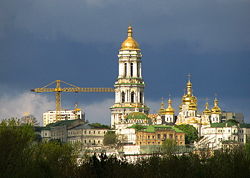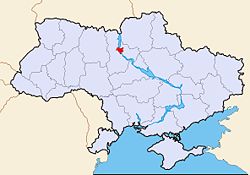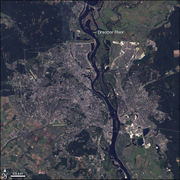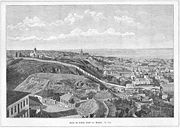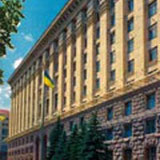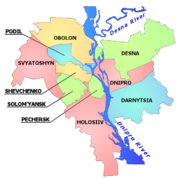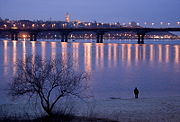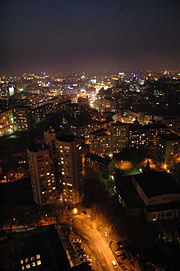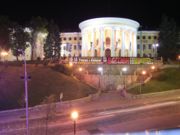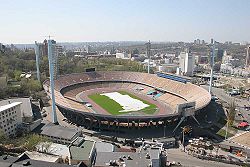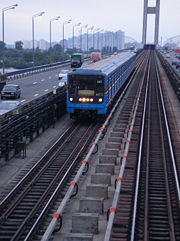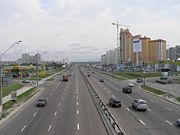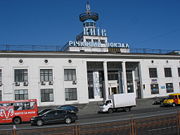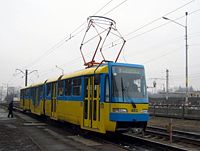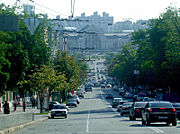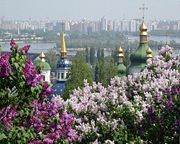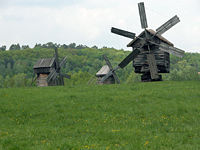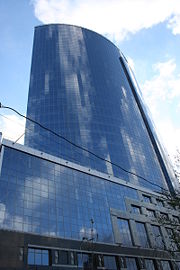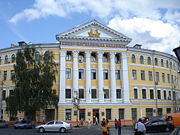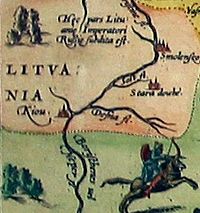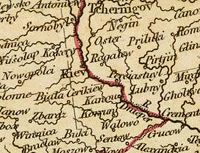Kiev
2008/9 Schools Wikipedia Selection. Related subjects: Europe; European Cities
| Kyiv Київ Kiev |
|||
| An old and a modern city. A construction crane and the towers of the Kiev Monastery of the Caves. | |||
|
|||
| Map of Ukraine with Kiev highlighted | |||
| Coordinates: | |||
|---|---|---|---|
| Country | |||
| Oblast | Kiev City Municipality | ||
| Raions |
List of 10
|
||
| Government | |||
| - Mayor | Leonid Chernovetskyi | ||
| Elevation | 179 m (587 ft) | ||
| Population (April, 2007) | |||
| - Total | 2.7 million (official est.) | ||
| - Density | 3,299/km² (8,544.4/sq mi) | ||
| Time zone | EET ( UTC+2) | ||
| - Summer ( DST) | EEST ( UTC+3) | ||
| Postal code | 01xxx-04xxx | ||
| Area code(s) | +380 44 | ||
| License plate | AA (before 2004: КА,КВ,КЕ,КН,КІ,KT) | ||
| Sister cities | Ankara, Athens, Belgrade, Brussels, Budapest, Chicago, Chişinău, Edinburgh, Florence, Helsinki, Kraków, Kyoto, Leipzig, Minsk, Munich, Odense, Paris, Pretoria, Riga, Rome, Santiago de Chile, Sofia, Stockholm, Tallinn, Tampere, Tbilisi, Toronto, Toulouse, Warsaw, Wuhan, Vienna, Vilnius, Pereira, Yerevan |
||
| Website: http://www.kmr.gov.ua | |||
Kiev, also spelled Kyiv ( Ukrainian: Київ , Kyyiv, IPA: [ˈkıjiʋ]; Russian: Ки́ев , Kiyev; see also Cities' alternative names), is the capital and the largest city of Ukraine, located in the north central part of the country on the Dnieper River. As of April 2007, official municipal estimates placed the population of Kiev at about 2.7 million inhabitants, although some much higher unofficial estimates are often published.
Kiev is an important industrial, scientific, educational and cultural centre of Eastern Europe. It is home to many high-tech industries, higher education institutions and world-famous historical landmarks. The city has an extensive infrastructure and highly developed system of public transport, including the Kiev Metro.
The name Kiev is said to derive from the name of Kyi, one of four legendary founders of the city (brothers Kyi, Shchek, Khoryv and sister Lybid'). During its history, Kiev, one of the oldest cities in Eastern Europe, passed through several stages of great prominence and relative obscurity. The city may have been founded in the 5th century as a trading post, perhaps part of the land of the early Slavs. It gradually acquired eminence as the centre of the East Slavic civilization, becoming in the tenth to twelfth centuries a political and cultural capital of Rus', a medieval East Slavic state. Completely destroyed during the Mongol invasion in 1240, the city lost most of its influence for the centuries to come. It was a provincial capital of marginal importance in the outskirts of the territories controlled by its powerful neighbors: first the Grand Duchy of Lithuania, followed by Poland and Russia. The city prospered again during the Russian industrial revolution in the late 19th century. After the turbulent period following the Russian Revolution of 1917, from 1921 onwards Kiev was an important city of the Ukrainian Soviet Socialist Republic, and, from 1934, its capital. During World War II, the city again suffered significant damage, but quickly recovered in the post-war years remaining the third largest city of USSR. Following the collapse of the Soviet Union and the Ukrainian independence of 1991, Kiev remained the capital of Ukraine.
Environment
Geography
Geographically, Kiev belongs to the Polesia ecological zone (a part of the European mixed woods). However, the city's unique landscape distinguishes it from the surrounding region.
Kiev is located on both sides of the Dnieper River, which flows south through the city towards the Black Sea. The older right-bank (western) part of the city is represented by numerous woody hills, ravines and small rivers. It is a part of the larger Dnieper Upland adjoining the western bank of the Dnieper in its mid-flow. Kiev expanded to the Dnieper's lowland left bank (to the east) only in the twentieth century. Significant areas of the left-bank Dnieper valley were artificially sand-deposited, and are protected by dams.
The Dnieper River forms a branching system of tributaries, isles, and harbors within the city limits. The city is adjoined by the mouth of the Desna River and the Kiev Reservoir in the north, and the Kaniv Reservoir in the south. Both the Dnieper and Desna rivers are navigable at Kiev, although regulated by the reservoir shipping locks and limited by winter freeze-over.
Climate
Kiev has a continental humid climate. The warmest months are June, July, and August, with mean temperatures of 13.8 to 24.8 °C (56.9 to 76.7 °F). The coldest are December, January, and February, with mean temperatures of −4.6 to -1.1 °C (23.7 to 30.0 °F). The highest ever temperature recorded in the city was 39.4 °C (103.0 °F) on 31 July 1936. The coldest temperature ever recorded in the city was -32.2 °C (-26.0 °F) on 7 & 9 February 1929. Snow cover usually lies from mid-November to the end of March, with the frost-free period lasting 180 days on average, but surpassing 200 days in recent years.
| Weather averages for Kiev | |||||||||||||
|---|---|---|---|---|---|---|---|---|---|---|---|---|---|
| Month | Jan | Feb | Mar | Apr | May | Jun | Jul | Aug | Sep | Oct | Nov | Dec | Year |
| Record high °C (°F) | 11.1 (52) | 17.3 (63) | 22.4 (72) | 29.1 (84) | 33.6 (92) | 35.0 (95) | 39.4 (103) | 39.9 (104) | 33.8 (93) | 29.5 (85) | 23.2 (74) | 13.4 (56) | 39.9 (104) |
| Average high °C (°F) | -2.9 (27) | -1.7 (29) | 3.6 (38) | 12.6 (55) | 20.3 (69) | 23.5 (74) | 25.3 (78) | 24.4 (76) | 19.3 (67) | 12.0 (54) | 4.1 (39) | -0.8 (31) | 11.7 (53) |
| Average low °C (°F) | -8.4 (17) | -7.7 (18) | -3.1 (26) | 3.9 (39) | 10.1 (50) | 13.3 (56) | 15.0 (59) | 14.0 (57) | 9.6 (49) | 4.3 (40) | -0.9 (30) | -5.4 (22) | 3.8 (39) |
| Record low °C (°F) | -31.1 (-24) | -32.2 (-26) | -24.9 (-13) | -10.4 (13) | -2.4 (28) | 2.4 (36) | 5.8 (42) | 3.3 (38) | -2.9 (27) | -17.8 (-0) | -21.9 (-7) | -30.0 (-22) | -32.2 (-26) |
| Precipitation mm (inches) | 47 (1.9) | 46 (1.8) | 39 (1.5) | 49 (1.9) | 53 (2.1) | 73 (2.9) | 88 (3.5) | 69 (2.7) | 47 (1.9) | 35 (1.4) | 51 (2) | 52 (2) | 649 (25.6) |
| Source: Pogoda.ru.net 8.09.2007 | |||||||||||||
History
Kiev is one of the oldest and most important cities of Eastern Europe and has played a pivotal role in the development of the medieval East Slavic civilization as well as in the modern Ukrainian nation.
Human settlement at the site of the present day city may have occurred as early as the fifth or the sixth century AD. With the exact time of city foundation being hard to determine, May 1982 was chosen to celebrate the city's 1,500th anniversary.
During the eighth and ninth centuries, Kiev was an outpost of the Khazar empire. Starting in the late ninth century Kiev was ruled by the Varangian nobility and became the nucleus of the Rus' polity, whose Golden Age (eleventh to early twelfth centuries) has from the nineteenth century become referred to as Kievan Rus'. In 1240 the Mongol invasion of Rus led by Batu Khan completely destroyed Kiev, an event that had a profound effect on the future of the city and the East Slavic civilization. At the time of the Mongol destruction, Kiev was reputed as one of the largest cities in the world, with a population exceeding one hundred thousand.
In 1321, the greatly diminished city and surrounding area was conquered by Gediminas for the Grand Duchy of Lithuania. From 1569 the city was controlled by the Polish-Lithuanian Commonwealth, as a capital of Kijów Voivodeship, transferred by then to the Polish Crown. In the 17th century, Kiev was transferred under rule of Russia. In the Russian Empire Kiev was a primary Christian centre, attracting pilgrims, and the cradle of many of the empire's most important religious figures, but until the 19th century the city's commercial importance remained marginal.
Kiev prospered again during the late nineteenth century industrial revolution in the Russian Empire, when it became the third most important city of the Empire and the major centre of commerce of its southwest. In the turbulent period following the 1917 Russian Revolution, Kiev became the capital of several short-lived Ukrainian states and was caught in the middle of several conflicts: World War I, the Russian Civil War, and the Polish-Soviet War. Kiev changed hands sixteen times from the end of 1918 to August 1920.
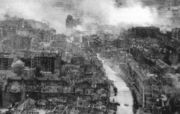
From 1921 the city was a part of the Ukrainian Soviet Socialist Republic, a founding republic of the Soviet Union. Kiev was greatly affected by all the major processes that took place in Soviet Ukraine during the interwar period: the 1920s Ukrainization as well as the migration of the rural Ukrainophone population made the recently Russophone city partly Ukrainian-speaking and propped up the development of the Ukrainian cultural life in the city; the Soviet Industrialization that started in end-1920s turned the city, a former centre of commerce and religion, into a major industrial, technological and scientific centre, the 1932-1933 Great Famine devastated the part of the migrant population not registered for the ration cards, and Stalin's 1930s Great Purge almost eliminated the city's intelligentsia
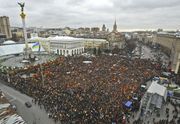
In 1934 Kiev became the capital of Soviet Ukraine. The city boomed again during the years of the Soviet industrialization as its population grew rapidly and many industrial giants were created, some of which exist to this day.
In World War II, the city again suffered significant damage, but quickly recovered in the post-war years, becoming once again the third most important city of the Soviet Union. The catastrophic accident at the Chernobyl Nuclear Power Plant occurred only 100 km north of the city. However, the prevailing northward winds blew the most substantial radioactive debris away from the city.
In the wake of the collapse of the Soviet Union the Declaration of Independence of Ukraine was proclaimed in the city by the Ukrainian parliament on August 24, 1991. Kiev is the capital of independent Ukraine.
Government
The municipality of the city of Kiev has a special legal status within Ukraine compared to the other administrative subdivisions of the country. The most significant difference is that the city is subordinated directly to the national-level branches of the Government of Ukraine, skipping the regional level authorities of Kiev Oblast. Additionally, the Head of City Administration -- the leading executive position is held by a directly elected, rather than appointed, figure, who is also the Head of City Council -- the Mayor of Kiev, and municipal institutions have a higher level of self governance than elsewhere in Ukraine.
Subdivisions
Formal subdivision
Administratively, the city is divided into " raions" ("districts"), which have their own locally elected governments with jurisdiction over a limited scope of affairs. Presently, there are 10 raions.
Informal subdivision
The Dnieper River naturally divides Kiev into the Right Bank and the Left Bank areas. The Right Bank, located on the western side of the river, contains the older portions of the city, as well as the majority of Kiev's business and governmental institutions. The eastern Left Bank is predominantly residential. There are large industrial and green areas in both the Right Bank and the Left Bank.
Kiev is further informally divided into historical or territorial neighborhoods, each housing from about 5,000 to 100,000 inhabitants.
Demographics
| Historical populations | ||
|---|---|---|
| Census | Pop. | %± |
| 1939 | 846,724 | N/A |
| 1940 | 930,000 | +9.8% |
| 1943 | 180,000 | -80.6% |
| 1959 | 1,104,334 | +513.5% |
| 1961 | 1,174,000 | +6.3% |
| 1979 | 2,144,000 | +82.6% |
| 1989 | 2,587,945 | +20.7% |
| 2001 | 2,611,327 | +0.9% |
| 2005 | 2,660,401 | +1.8% |
As of the All-Ukrainian Census conducted on December 5, 2001, the population of Kiev is 2,611,300. The historic changes in population is shown in the side table. According to the census, men accounted for 1,219,000 persons, or 46.7%, and women – 1,393,000 persons, or 53.3%. Comparing the results with the previous census (1989) shows the trend of population aging which, while prevalent throughout the country, is partly offset in Kiev by the inflow of working age migrants.
According to the census data, more than 130 nationalities and ethnic groups reside within the territory of Kiev. Ukrainians constitute the largest ethnic group in Kiev, and they account for 2,110,800 people, or 82.2% of the population. Russians comprise 337,300 (13.1%), Jews - 17,900 (0.7%), Belarusians - 16,500 (0.6%), Poles - 6,900 (0.3%), Armenians - 4,900 (0.2%), Azerbaijanis - 2,600 (0.1%), Tatars - 2,500 (0.1%), Georgians - 2,400 (0.1%), Moldovans - 1,900 (0.1%).
Both Ukrainian and Russian are commonly spoken in the city, with Russian being more widely used despite the fact that Ukrainian is claimed as their native language by almost three times as many residents as those who claim Russian. According to a 2006 survey, Ukrainian is used at home by 23% of Kievans, as 52% use Russian and 24% switch between both.
Some 1,069,700 people have higher or completed secondary education, a significant increase of 21.7% since 1989.
The latest (April, 2007) municipal estimate of the city population is of 2.7 million residents. Other much higher estimates are often published. For instance, the amount of bakery products sold in the city (thus including temporary visitors and commuters) gives a minimum of 3.5 million people (June, 2007).
Modern Kiev
Modern Kiev is a mix of the old and the new, seen in everything from the architecture to the stores and to the people themselves. Experiencing great population growth between the 1970s and the mid- '90s, the city has continued its consistent growth after the turn of the millennium. As a result, Kiev's "downtown" is a dotted contrast of new, modern buildings amongst the pale yellows, blues and grays of older apartments. Urban sprawl has gradually reduced, while population densities of suburbs has increased. The most expensive properties are located in the Pechersk, and Khreschatyk areas. It is also prestigious to own a property in newly constructed buildings in the Kharkivskyi Raion or Obolon along the Dnieper.
Ukrainian independence at the turn of the millennium has heralded other changes. Western-style residential complexes, modern nightclubs, classy restaurants and prestigious hotels opened in the centre. Music from Europe and North America started appearing on Ukrainian music charts. And most importantly, with the easing of the visa rules in 2005, Ukraine is positioning itself as a prime tourist attraction, with Kiev, among the other large cities, looking to profit from new opportunities. The centre of Kiev has been cleaned up and buildings have been restored and redecorated, especially the Khreschatyk street and the Independence Square. Many historic areas of Kiev, such as Andriyivskyy Descent, have become popular street vendor locations, where one can find traditional Ukrainian art, religious items, books, game sets (most commonly chess) as well as jewelry for sale.
Culture
A historic cultural centre of the East Slavic civilization and a major cradle of Christianization for what became the Belarusian, Russian and Ukrainian nations, Kiev retained through centuries its cultural importance and even at times of relative decay, it remained the centre of the Eastern Orthodox Christianity of the primary importance. Its holy sites, of which the Kiev Pechersk Lavra (the Monastery of the Caves) and the Saint Sophia Cathedral are probably the most famous, attracted pilgrims for centuries and now recognized as UNESCO World Heritage Sites remain the primary religious centres as well as the major tourist attraction.
An important part of Kiev's culture is the many theatres in the city, which include: Kiev Opera House, Ivan Franko National Academic Drama Theatre, Lesya Ukrainka National Academic Theatre of Russian Drama, the Kiev Puppet Theatre, October Palace, National Philharmonic of Ukraine and many others.
Other cultural items include the Dovzhenko Film Studios, and the Kiev Circus. The most important of the city's many museums are the Kiev State Historical Museum, Museum of the Great Patriotic War, the National Art Museum, the Museum of Western and Oriental Art and the National Museum of Russian art.
In 2005 Kiev hosted the 50th annual Eurovision Song Contest as a result of Ruslana's Wild Dances being victorious in 2004.
Sports
Football is the most popular spectator sport in Kiev, followed by basketball and ice hockey. Kiev has many professional and amateur football clubs, including the Arsenal and Dynamo, which both play in the top division of the Ukrainian Premier League. Other less prominent sport clubs in the city include: the FC Obolon Kyiv soccer club, the HC Sokil Kyiv hockey club and BC Kyiv basketball club.
During the 1980 Summer Olympics held in the Soviet Union, Kiev held the preliminary matches and the quarter-finals of the football tournament at its Olympic Stadium, reconstructed for the event. The stadium is the largest of Ukrainian stadiums, as well as among Kiev's 15 stadiums/sport complexes. Initially constructed for audience of 100,000, following the installation of individual seats it can now accommodate 83,053 spectators. Other notable sport stadiums/sport complexes in Kiev include the Lobanovsky Dynamo Stadium, the Palace of Sports, among many others.
Kiev does not only host field games and indoor sports, but also aquatic sports, which take place on the Kiev Reservoir at Vyshhorod, and on Trukhaniv Island in the Dnieper river, opposite the city centre, where there are many fine beaches and recreational facilities. In addition to that, cross country bicycling is another favourite sport, also taking place on the Trukhaniv Island.
Together with a few other cities of Poland and Ukraine, Kiev will house the 2012 UEFA European Football Championship. Three group matches, a quarter final and the final are scheduled to be played at Kiev NSK Olimpiyskyi stadium.
Architecture
Probably, Kiev's most famous historical architecture complexes are the St. Sophia Cathedral and the Kiev Pechersk Lavra (Monastery of the Caves), which are UNESCO World Heritage Sites.
Noteworthy historical architectural landmarks also include the Mariyinsky Palace (designed and constructed from 1745 to 1752, then reconstructed in 1870), several Orthodox churches such as St. Michael's Cathedral, St. Andrew's, St. Vladimir's, the reconstructed Golden Gate and others.
One of Kiev's widely recognized modern landmarks is the highly visible giant Mother Motherland statue standing at the Museum of the Great Patriotic War on the Right bank of the Dnieper River. Other notable sites is the cylindrical Salut hotel, located across from Glory Square and the eternal flame at the World War Two memorial Tomb of the Unknown Soldier.
Among Kiev's best-known monuments are Mikeshin's statue of Bohdan Khmelnytsky astride his horse located near St. Sophia Cathedral, the venerated Vladimir the Great (St. Vladimir), the baptizer of Rus', overlooking the river above Podil, the monument to Kyi, Schek and Khoryv and Lybid, the legendary founders of the city located at the Dnieper embankment. On Independence Square in the city centre, two tall columns elevate two modern monuments of the city protectors; the historic protector of Kiev Michael Archangel and a modern invention, the goddess-protector Berehynia.
Architectural monuments
Transportation
Local transportation
Public transportation in Kiev includes the metro (underground), buses, trolleybuses and trams. The publicly owned and operated Kiev Metro system is the fastest, the most convenient and affordable network that covers most, but not all, of the city. The metro is continuously expanding towards the city limits to meet growing demand, while the other kinds of public transport are not that well maintained. In particular, the public bus service has an unreliable schedule. Public electric trolleybus and tram lines are more reliable, but have aged equipment and are underfunded. The historic tram system, which once was a well maintained and widely used method of transport, is now gradually being phased out in favour of buses and trolleybuses.
One unique mode of public transportation Kiev has is the funicular, that climbs up the steep right bank of the Dnieper River. It transports 10,000-15,000 passengers daily.
All public road transport in Kiev is operated by the united Kyivpastrans municipal company. It is heavily subsidized by the city as large groups of passengers (pensioners, etc.) are granted free service on its lines.
The Kiev public transport system uses a simple tariff system regardless of distance travelled: tickets for ground transportation must be purchased each time a vehicle boarded. Discount passes are available for scholars and students. Pensioners use public transportation free. Monthly passes, which are sold at the price of 60 rides, are also available in all combinations of public transportation: metro, bus, trolley, tram.
Recently, privately owned minibuses, marshrutkas, have appeared on Kiev streets. They provide good coverage of smaller residential streets and have convenient routes. Minibuses take fewer passengers, run faster, stop on demand and are more available, although with an increased frequency of accidents. Ticket price and itinerary of private minibuses are regulated by the city government, and the cost of one ride, while higher than on public buses, is still far lower than in Western Europe.
The taxi market in Kiev is expansive but not adequately regulated. In particular, the taxi fare per kilometer is not regulated. There is strong competition between private taxi companies. Many allow scheduling a pick-up by phone. Also, it is quite common for a local with a car (or even people from other parts of Ukraine) to provide taxi service on the ad hoc basis. Traffic jams and lack of parking space are growing problems for taxi services in Kiev. Current regulations allow for parking on pavements, which pedestrians may find inconvenient.
Suburban transportation
Suburban transportation is provided by buses and short-range trains ( elektrichkas). There are a few bus stations inside the city providing suburban transportation. Private minibuses (marshrutkas) provide faster and more frequent suburban service, currently winning the competition against large buses.
Elektrichkas are serviced by the publicly owned Ukrzaliznytsia company. The suburban train service is fast, and unbeatably safe in terms of traffic accidents. But the trains are not reliable, as they may fail significantly behind schedule, may not be safe in terms of crime, and the elektrichka cars are poorly maintained and are overcrowded in rush hours.
There are 5 elektrichka directions from Kiev:
- Nizhyn (north-eastern)
- Hrebinka (south-eastern)
- Myronivka (southern)
- Fastiv (south-western)
- Korosten (western)
More than a dozen of elektrichka stops are located within the city allowing residents of different neighborhoods to use the suburban trains.
The previously extensive riverboat service along the Dnieper featuring the Meteor and Raketa hydrofoil ships is no longer available, limiting Kiev's river transport to cargo and tour boats and private pleasure craft.
Railways
Railways are Kiev’s main mode of intracity transportation. The city has a developed railroad infrastructure including a long-distance passenger station, 6 cargo stations, depots, and repairing facilities. However, this system still fails to meet the demand for passenger service. Particularly, the Kiev Passenger Railway Station is the city's only long-distance passenger terminal (vokzal). Construction is underway for a new Darnytsia Railway Station on the left-bank part of Kiev, which may ease traffic at the central station. Bridges over the Dnieper River are another problem restricting the development of city’s railway system. Presently, only one rail bridge out of two is available for intense train traffic. A new combined rail-auto bridge is under construction, as a part of Darnytsia project.
Air transport
Air passengers arrive in Kiev through one of two airports: the Boryspil Airport which is served by many international airlines, and the smaller Zhulyany Airport, serving mostly domestic flights and limited flights to nearby countries. The international passenger terminal at Boryspil is small, yet modern. Its international terminal was expanded in 2006. There is a separate terminal for domestic flights within walking distance. Passengers flying to other countries from Ukraine usually travel through Boryspil, as other airports in Ukraine such as Donetsk, Simferopol, Odessa, provide very limited international connections. There is also Gostomel cargo airport in Kiev's north-western suburb of Hostomel.
Kiev is notable in the world of aviation industry as the headquarters for Antonov aircraft manufacturing company.
Tourism
Attractions in Kiev
It is said that one can walk from one end of Kiev to the other in the summertime without leaving the shade of its many trees. Most characteristic are the horse-chestnuts ( Ukrainian: каштани, kashtany).
Kiev is known as a green city with two botanical gardens and numerous large and small parks. The green nature of the city is probably most notable by the green hills of the right bank along the Dnieper river that have been relatively untouched by development. The World War II Museum is located here, which offers both indoor and outdoor displays of military history and equipment surrounded by verdant hills overlooking the Dnieper river.
Among the numerous islands, Venetsianskyi (or Hidropark) is the most developed. It is accessible by metro or by car, and includes an amusement park, swimming beaches, boat rentals, and night clubs. The Victory Park (Park Peremohy) located near Darnytsia subway station is a popular destination for strollers, joggers, and cyclists.
Boating, fishing, and water sports are popular pastimes in Kiev. The area lakes and rivers freeze over in the winter and ice fishermen are a frequent sight, as are children with their ice skates. However, the peak of summer draws out a greater mass of people to the shores for swimming or sunbathing, with daytime high temperatures sometimes reaching 30 to 34 °C (86–93 °F).
The centre of Kiev ( Independence Square and Khreschatyk Street) becomes a large outdoor party place at night during summer months, with thousands of people having a good time in nearby restaurants, clubs and outdoor cafes. The central streets are closed for auto traffic on weekends and holidays.
A wide variety of farm produce is available in many of Kiev's farmer markets with the Besarabsky Market located in the very centre of the city being most famous. Each residential region has its own market, or rynok. Here one will find table after table of individuals hawking everything imaginable: vegetables, fresh and smoked meats, fish, cheese, honey, dairy products such as milk and home-made smetana (sour cream), caviar, cut flowers, housewares, tools and hardware, and clothing. Each of the markets has its own unique mix of products with some markets devoted solely to specific wares such as automobiles, car parts, pets, clothing, flowers, etc.. There is also a popular book market by the Petrivka metro station.
At the city's southern outskirts, near the historic Pyrohiv village, there is an outdoor museum, officially called the Museum of Folk Architecture and Life of Ukraine It has an area of 1.5 square kilometres (1 sq mi). This territory houses several "mini-villages" that represent by region the traditional rural architecture of Ukraine.
Kiev also has numerous recreational attractions like bowling alleys, go-cart tracks, paintball venues, billiard halls and even shooting ranges. 100-year-old Kiev Zoo is located on 40 hectares and carries over 2,000 specimens.
Economy
Kiev, as the capital of Ukraine, is a major administrative centre housing amongst others ministries responsible for the economy of the country. Factories in Kiev are found in all parts of the city, with a major concentration of industrial organizations to the west of the city centre and on the left bank of the Dnieper River.
Industrial organizations
The Kiev engineering plants manufacture their equipment utilizing metal from the iron and steel areas of Dnipropetrovshchyna and the Donbas coalfield. These plants in Kiev make equipment for chemical plants, such as conveyor lines for vulcanized rubber, linoleum, fertilizer factories, and also metal-cutting machines. Other engineering products of Kiev area include aircraft (see: Antonov), hydraulic elevators, electrical instruments, armatures, river-and-sea crafts, motorcycles, and cinematography equipment.
Another important sector is the chemical industry, which produces resin products, fertilizers, plastics, and chemical fibers, made at the Darnytsky Raion viscose plant on the left bank of Kiev. Lumber milling and the production of bricks and reinforced concrete items are another well developed industry. Consumer manufactured goods include cameras (see: Kiev-Arsenal (photo camera), thermos flasks, knitwear, footwear, a range of foodstuffs, and hand watches. Kiev is also a large publishing centre.
Power production
Kiev is supplied by electricity primary from the Kiev Hydroelectric Power Station, completed in 1968, just upstream of the city at Vyshhorod, on the Kiev Reservoir, and from Trypillia thermal electric station. Following the Chernobyl accident the Chernobyl Nuclear Power Plant located 100 km north of Kiev has been closed. Kiev also receives its power supply in the form of natural gas, piped from Urengoy-Pomary- Uzhhorod pipeline.
Education
Kiev hosts many universities, the major ones being Kiev National Taras Shevchenko University, the National Technical University "Kiev Polytechnic Institute", and the Kyiv-Mohyla Academy. The total number of institutions of higher education in Kiev approaches 200, allowing young people to pursue almost any line of study.
There are about 500 general secondary schools, evening schools for adults, and specialist technical schools. Scientific research is conducted in many of the institutes of the higher education and, additionally, in many research institutes affiliated with the Ukrainian Academy of Sciences and several of Ukrainian industrial ministries. Kiev is also noted for its research in medicine and computer science.
There are many libraries in the city with the Vernadsky library affiliated with the Academy of Science being the largest and most important one.
City name evolution
Currently, Kiev is the traditional and most commonly used English name for the city, but since the 1995 adoption of Kyiv by the Ukrainian government as a preferred spelling, the Ukrainianized version Kyiv is gaining usage.
As a prominent city with a long history, its English name was subject to gradual evolution. The early English spelling was derived from Old East Slavic form Kyjevъ ( Cyrillic: Къıєвъ), derived from Kyi ( Cyrillic: Кий), the legendary founder of the city.
Early English sources use various names, including Kiou, Kiow, Kiew, Kiovia. On one of the oldest English maps of the region, Russiae, Moscoviae et Tartariae published by Ortelius (London, 1570) the name of the city is spelled Kiou. On the 1650 map by Guillaume de Beauplan, the name of the city is Kiiow, and the region was named Kÿowia. In the book Travels, by Joseph Marshall (London, 1772), the city is referred to as Kiovia. While the choice of these spellings have likely been influenced by the Polish name of the city ( Polish: Kijów) as until mid-seventeenth century the city was controlled by Poland, the name Kiev [ˈkijef] that started to take hold at later times, likely originates on the basis of Russian orthography and pronunciation [ˈkijef], during a time when Kiev was in the Russian Empire (since 1708 a centre of a Governorate).
In English, Kiev was used in print as early as in 1804 in the John Cary's "New map of Europe, from the latest authorities" in "Cary's new universal atlas" published in London. The English travelogue titled New Russia: Journey from Riga to the Crimea by way of Kiev, by Mary Holderness was published in 1823. By 1883, the Oxford English Dictionary included Kiev in a quotation. Kiev is also based on the old Ukrainian language spelling of the city name and was used by Ukrainians and their ancestors from the time of Kievan Rus until only about the last century.
Kyiv ([ˈkɪjiw]) is the romanized version of the name of the city used in modern Ukrainian. Starting from the twentieth century it has been used in English-language publications of the Ukrainian diaspora and in some academic publications concerning Ukraine. Following the independence in 1991, the Ukrainian government introduced the national rules for transliteration of geographic names from Ukrainian into English. According to the rules, Ukrainian Київ transliterates into Kyiv. This has established the use of the spelling Kyiv in all official documents issued by the governmental authorities since October 1995. The spelling is used by the United Nations, all English-speaking foreign diplomatic missions, several international organizations, Encarta encyclopedia, and by some media, notably in Canada and Ukraine. On October 3, 2006, the United States federal government changed its official spelling of the city name to Kyiv. The proponents of Kyiv are using different ways to promote this spelling. In February 2008 Kyiv was competing for a spot in new Monopoly World Edition game board. The internet voting organized by Monopoly's producer, Hasbro has attracted attention of Ukrainian net users.
The alternate romanizations Kyyiv (BGN/PCGN transliteration) and Kyjiv (scholarly) are also in use in English-language atlases. Most major English-language news sources continue to use Kiev.
